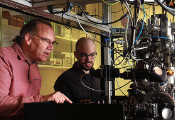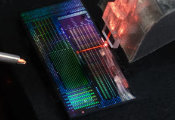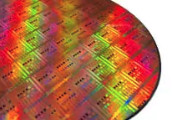Landmark Study Is Step Towards Energy-Efficient Quantum Computing in Magnets
29 May 2024 -- Researchers from Lancaster University and Radboud University Nijmegen have managed to generate propagating spin waves at the nanoscale and discovered a novel pathway to modulate and amplify them. Their discovery, published in Nature, could pave the way for the development of dissipation free quantum information technologies. As the spin waves do not involve electric currents these chips will be free from associated losses of energy.
The rapidly growing popularity of artificial intelligence comes with an increasing desire for fast and energy efficient computing devices and calls for novel ways to store and process information. The electric currents in conventional devices suffer from losses of energy and subsequent heating of the environment. One alternative for the “lossy” electric currents is to store and process information in waves, using the spins of the electrons instead of their charges. These spins can be seen as the elementary units of magnets.
Lead author Dr Rostislav Mikhaylovskiy from Lancaster University said: “Our discovery will be essential for future spin-wave based computing. Spin waves are an appealing information carrier as they don’t involve electric currents and therefore do not suffer from resistive losses.”
It has already been known for many years that spins can be kicked out of their equilibrium orientation. After this perturbation, the spins start to precess (i.e. rotate) around their equilibrium position. In magnets neighbouring spins are extremely strongly coupled, forming a net magnetization. Due to this coupling, the spin precession can propagate in the magnetic material, giving rise to a spin wave.
“Observing nonlinear conversion of coherent propagating magnons at nanoscale, which is a prerequisite for any practical magnon-based data processing, has been sought for by many groups worldwide for more than a decade. Therefore, our experiment is a landmark for spin wave studies, which holds the potential to open an entire new research direction on ultrafast coherent magnonics with an eye on the development of dissipation free quantum information technologies.”
The researchers have used the fact that the highest possible frequencies of the spin rotations can be found in materials, in which adjacent spins are canted with respect to each other. To excite such fast spin dynamics, they used a very short pulse of light, the duration of which is shorter than the period of the spin wave, i.e. less than a trillionth of a second. The trick for generating the ultrafast spin wave at the nanoscale is in the photon energy of the light pulse. The material of study exhibits extremely strong absorption at ultraviolet (UV) photon energies, which localises the excitation in a very thin region of only a few tens of nanometres from the interface, which allows spin waves with terahertz (a trillion of Hertz) frequencies and sub-micrometre wavelengths to emerge.
The dynamics of such spin waves is intrinsically nonlinear, meaning that the waves with different frequencies and wavelengths can be converted into each other. The researchers have now for the first time realized this possibility in practice. They achieved this by exciting the system not with only one, but with two intense laser pulses, separated by a short time delay.
First author Ruben Leenders, former PhD student at Lancaster University, said: “In a typical single pulse excitation experiment, we would simply expect the two spin waves to interfere with each other as any waves do. However, by varying the time delay between the two pulses we found that this superposition of the two waves does not hold.”
The team explained the observations by considering the coupling of the already excited spin wave with the second light pulse. The result of this coupling is that when the spins are already rotating, the second light pulse gives an additional kick to the spins. The strength and the direction of this kick depends on the state of the deflection of the spins at the time that this second light pulse arrives. This mechanism allows for control over the properties of the spin waves such as their amplitude and phase, simply by choosing the appropriate time delay between the excitations.




































